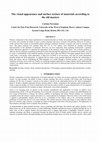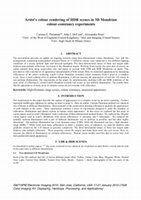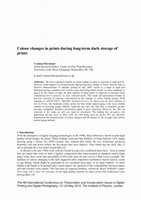Papers by Carinna Parraman
As more robust methods for ultra-violet (UV) curable inkjet printing are being introduced to mark... more As more robust methods for ultra-violet (UV) curable inkjet printing are being introduced to market, alternative color and decorative printing methods have been tested for the art, design, and J. Imaging Sci.
The objective is to create a micro-environment -an illuminated dome with a constant geometry of i... more The objective is to create a micro-environment -an illuminated dome with a constant geometry of illumination -to undertake non invasive observation of the surface topography of artworks. The dome is attached to a stereo-microscope, which is able to gain -at the same time -both colour and texture features of the sample. By using a stereo-microscope, a more detailed observation is possible. Important elements including colour, texture, the morphology of the sample surface, in terms of specular and diffused components of reflected light, can be summarized/condensed in the measure of Bidirectional Texture Function.

Primary components in the colour reproduction of textured materials are firstly, the accurate ren... more Primary components in the colour reproduction of textured materials are firstly, the accurate rendering of the appearance of texture, and secondly the ability to print a surface topology that moves towards 2.5D printing. However, in order to render surfaces that contain no discernable pattern structure, unlimited variations in pattern can result in enormous file sizes. The paper explores how painters from the 15 th to 21st century were absorbed in creating convincing representations of the attributes of materials. However, on close inspection, these paintings demonstrate a gestural, almost abstracted approach to capturing the appearance of the material, surface and object. The evolving question is: what are the key elements in paintings produced by artists that through the application of coloured brush marks, are able to create a verisimilitude of the material qualities of wood, metal, glass and fabric? The paper suggests that in order to create both a convincing visual appearance, a high level of detail is not necessary, and, that too much information possibly hinders the final appearance. It suggests that by using a more gestural approach, whereby the relationship of mark and colour, and by modulating the fluid dynamics of a mark through a textured surface, a more convincing rendering of texture can be achieved. Finally, by exploring analogue approaches to image making, and by addressing the complex way digital images are constructed, new methods could assist in reducing huge memory and image processing requirements.

International Colour Society (AIC) congress at The Sage Gateshead, (July 2013), 2013
This paper considers alternative approaches to image making and printing that moves from the on-s... more This paper considers alternative approaches to image making and printing that moves from the on-screen representation of images and painting applications, to the physical generation and methods for surface deposition or 2.5D printing. The research investigates the application of new materials and print processes, as an alternative to four-colour separation and halftoning. This paper describes two routes: the development of photographic continuous tone prints by varying the depth of pigment to create a surface topology, and secondly, the application of pigments that emulates a painting method to create a physical textured surface. Both methods differ from traditional halftoning screening in as much they incorporate a vector approach to image construction. In both cases, the objective is not just to apply an image to an extruded or textured surface, but where the relationship of surface deposition and image are integral.
International Colour Society (AIC) congress at The Sage Gateshead, (July 2013), 2013
Our current digital technologies are as much a part of the cultural heritage of tomorrow as are t... more Our current digital technologies are as much a part of the cultural heritage of tomorrow as are the material objects we create and the discourses and narratives that bind theory and practice. In this fast moving technological environment, with increasing specialisation in those fields of practice engaged with colour, how do different disciplines in art, design and the sciences communicate theories and practice across their boundaries?
The chapters contained in the appendix are presented as background information to support the mai... more The chapters contained in the appendix are presented as background information to support the main body of the thesis. The appendix includes the technical detail of early experiments and background reference data for the reader.
The appendix also includes a visual timeline of artists and technologists’ colour models, which are referenced in the body of the thesis. The timeline demonstrates the different methods of colour classification, from those using lines and circles to two and three dimensional models and diagrams, which can be read from left (prehistoric models) to the right (contemporary models).
As a demonstration of dissemination and knowledge exchange, there is also a list of meetings, publications, papers and workshops that were undertaken during the period of research.

Abstract
The motivation for this research is based on how artists mix and print colour by tradi... more Abstract
The motivation for this research is based on how artists mix and print colour by traditional means (painting and printmaking) and how these differ from colour picker tools, slider bars and methods developed for digital printing, and whether it is possible to incorporate both? Artists have been expert at mixing colour for centuries, yet although the artist and designer has access to a wide range of digital imaging tools and technologies, that on first glance, are dedicated to the creation of colour mixtures, the resulting colours are often disappointing. It appears that hardware, software tools and methods for digital printing are not necessarily suited to the specific requirements of the artist. In fact, they are too generalised to obtain a high degree of quality and too inflexible to allow artists to obtain precision and predictability. Based on existing hardware and software, the paper suggests alternative approaches to custom colour ink mixing and printing. Through the development of alternative ink colours specifically mixed
for inkjet printing the paper demonstrates specially designed charts for printing and double printing of custom mixed inks.
This paper presents a review of research undertaken into algorithms for colour enhancement method... more This paper presents a review of research undertaken into algorithms for colour enhancement methods based on the behaviour of the human vision system and the applied research in film, photography and print. These colour enhancements methods perform automatic adjustments that are based on the content of the image without the need of any statistic or a-priori knowledge about it. We have found that it can have a range of benefits and implications for enhancement of new images and restoration of deteriorated images. This paper presents an overview of series of research projects that have been undertaken since 2005 and which are still being explored as new algorithms are being introduced and refined. The paper will discuss the strengths and limits of this approach.

The presentation provides an update on ongoing research using three-dimensional Colour Mondrians.... more The presentation provides an update on ongoing research using three-dimensional Colour Mondrians. Two still life arrangements comprising hand-painted coloured blocks of 11 different colours were subjected to two different lighting conditions of a nearly uniform light and directed spotlights. The three-dimensional nature of these test targets adds shadows and multiple reflections, not found in flat Mondrian targets. Working from exactly the same pair of scenes, an author painted them using watercolour inks and paints to recreate both LDR and HDR Mondrians on paper. This provided us with a second set of appearance measurements of both scenes. Here we measured appearances by measuring reflectances of the artist's rendering. Land's Colour Mondrian extended colour constancy from a pixel to a complex scene. Since it used a planar array in uniform illumination, it did not measure the appearances of real life 3-D scenes in non-uniform illumination. The experiments in this paper, by simultaneously studying LDR and HDR renditions of the same array of reflectances, extend Land's Mondrian towards real scenes in non-uniform illumination. The results show that the appearances of many areas in complex scenes do not correlate with reflectance.

We studied color constancy using a pair of 3-D Color Mondrian displays made of two identical sets... more We studied color constancy using a pair of 3-D Color Mondrian displays made of two identical sets of painted wooden shapes. There are only 6-chromatic, and 5-achromatic paints applied to nearly 100 block facets. The three-dimensional nature of these test targets adds shadows and multiple reflections not found in flat Mondrians. Observers viewed one set in uniform illumination--Low-Dynamic-Range(LDR); the other in highly directional non-uniform illumination- High-Dynamic Range(HDR). Both 3-D Mondrians, were side-by-side, in the same room, at the same time. We used two measurement techniques to evaluate how well the appearances correlated with the object’s reflectances. First, we asked observers to compare the appearances of individual three-dimensional surfaces having identical reflectances, and recorded these changes in appearance using magnitude estimation.
Second, an author painted a reproduction of the pair of Mondrians using watercolors. We measured the watercolor reflectances of the corresponding areas to quantify the change in appearances. Both measurements give us important data on how reflectance, illumination and image structure affect color constancy. A constant paint does not exhibit perfect color constancy, but rather shows significant shifts in lightness, hue and chroma in response to nonuniform illumination.
The group CREATE - Colour Research for European Advanced Technology Employment - came together in... more The group CREATE - Colour Research for European Advanced Technology Employment - came together in 2006 to promote and exchange research and knowledge about colour through a series of conferences and training courses. The courses and conferences began in September 2007 and will end in June 2010. The long-term objective is to develop between artists, designers, technologists and scientists a cross disciplinary approach to improving the professional use of colour. This paper reports on the developments and activities of the Create group and its most recent event on cultural heritage: “Colour Heritage and Conservation”, which was held in Italy in October 2009.

In this changing environment in which the artist and designer has access to a wide range of digit... more In this changing environment in which the artist and designer has access to a wide range of digital imaging tools and technologies, that on first glance, are dedicated to the creation of colour mixtures, why is the digital interface and colour outcome often disappointing? It appears that hardware, software tools and methods for digital printing are not necessarily suited to the specific requirements of the artist. In fact, they are too generalised to obtain a high degree of quality and too inflexible to allow artists to obtain precision and predictability. Is it possible for an artist to mix and print a colour that captures their creative imagination? The motivation for this research is based on how artists mix and print colour by traditional means (painting and printmaking) and how these differ from colour picker tools, slider bars and methods developed for digital printing, and whether it is possible to incorporate both? The paper provides a brief historical background to artists who have developed colour systems to assist their particular colour choices. Based on existing hardware and software, the paper suggests alternative approaches to colour selection, demonstrates methods for the creation of novel inkjet printed palettes, and how these can be visualised and compared.

spie.org
For many centuries artists have considered and depicted illumination in art, from the effect of s... more For many centuries artists have considered and depicted illumination in art, from the effect of sunlight on objects at different times of the day, of shadows and highlights as cast by the moon, through indirect light as that through an open window or the artificial light of the candle or firelight. The presentation will consider artists who were fascinated by the phenomena of natural and artificial illumination and how they were able to render the natural world as a form of dynamic range through pigment. Artists have been long aware of the psychological aspects of the juxtaposition of colour in exploiting the optical qualities and arranging visual effects in painting and prints. Artists in the 16th century were attempting to develop an extended dynamic range through multi-colour, wood-block printing. Artists working at the height of naturalist realism in the 17th through the 19th century were fascinated by the illusory nature of light on objects. The presentation will also consider the interpretation of dynamic range through the medium of mezzotint, possibly the most subtle of printing methods, which was used by printers to copy paintings, and to create highly original works of art containing a dynamic range of tones.

The most significant impact on colour fading in prints is exposure to light and air.However what ... more The most significant impact on colour fading in prints is exposure to light and air.However what happens to coloured prints during long-term storage in boxes, drawers and on shelves? Measurements of samples, printed in July 2005, stored in a range of light and
darkened storage conditions have shown some interesting initial results. As more emphasis is placed on the effects of light, the dark stability of inkjet prints is relatively overlooked when considering how to preserve or store coloured prints. This study and presentation builds on previous research [1] and has concentrated on the changes to colour during storage. With reference to ASTM F2035 - 00(2006) Standard Practice for Measuring the Dark Stability of Ink Jet Prints, the Standards outline points out that whilst natural aging is the most reliable method of assessing image stability, materials and inks any data that is produced quickly becomes redundant; therefore accelerated aging is more preferred. However, the fine art materials in this study are still very much in circulation. The leading fine art papers, and pigmented ink-sets used in these trials are still being used by artists. We can therefore demonstrate the characteristics of colour changes and the impact of ink on paper that utilises natural aging methods.
spie.org
This paper presents an alternative view of colour, from the artist's perspective. It... more This paper presents an alternative view of colour, from the artist's perspective. It highlights problems that are current in inkjet and wideformat printing. And how other print processes, such as (silk)screenprint, can offer answers to developing inkjet technology; such as colour ...
Citeseer
This paper presents how inkjet colour is affected by firstly the substrate and secondly exposure ... more This paper presents how inkjet colour is affected by firstly the substrate and secondly exposure to light and the combination of both. The research uses both pigmented and dye based inks printed onto coated and uncoated fine art papers, and are subjected to light conditions that are ...
Books by Carinna Parraman





Uploads
Papers by Carinna Parraman
The appendix also includes a visual timeline of artists and technologists’ colour models, which are referenced in the body of the thesis. The timeline demonstrates the different methods of colour classification, from those using lines and circles to two and three dimensional models and diagrams, which can be read from left (prehistoric models) to the right (contemporary models).
As a demonstration of dissemination and knowledge exchange, there is also a list of meetings, publications, papers and workshops that were undertaken during the period of research.
The motivation for this research is based on how artists mix and print colour by traditional means (painting and printmaking) and how these differ from colour picker tools, slider bars and methods developed for digital printing, and whether it is possible to incorporate both? Artists have been expert at mixing colour for centuries, yet although the artist and designer has access to a wide range of digital imaging tools and technologies, that on first glance, are dedicated to the creation of colour mixtures, the resulting colours are often disappointing. It appears that hardware, software tools and methods for digital printing are not necessarily suited to the specific requirements of the artist. In fact, they are too generalised to obtain a high degree of quality and too inflexible to allow artists to obtain precision and predictability. Based on existing hardware and software, the paper suggests alternative approaches to custom colour ink mixing and printing. Through the development of alternative ink colours specifically mixed
for inkjet printing the paper demonstrates specially designed charts for printing and double printing of custom mixed inks.
Second, an author painted a reproduction of the pair of Mondrians using watercolors. We measured the watercolor reflectances of the corresponding areas to quantify the change in appearances. Both measurements give us important data on how reflectance, illumination and image structure affect color constancy. A constant paint does not exhibit perfect color constancy, but rather shows significant shifts in lightness, hue and chroma in response to nonuniform illumination.
darkened storage conditions have shown some interesting initial results. As more emphasis is placed on the effects of light, the dark stability of inkjet prints is relatively overlooked when considering how to preserve or store coloured prints. This study and presentation builds on previous research [1] and has concentrated on the changes to colour during storage. With reference to ASTM F2035 - 00(2006) Standard Practice for Measuring the Dark Stability of Ink Jet Prints, the Standards outline points out that whilst natural aging is the most reliable method of assessing image stability, materials and inks any data that is produced quickly becomes redundant; therefore accelerated aging is more preferred. However, the fine art materials in this study are still very much in circulation. The leading fine art papers, and pigmented ink-sets used in these trials are still being used by artists. We can therefore demonstrate the characteristics of colour changes and the impact of ink on paper that utilises natural aging methods.
Books by Carinna Parraman
The appendix also includes a visual timeline of artists and technologists’ colour models, which are referenced in the body of the thesis. The timeline demonstrates the different methods of colour classification, from those using lines and circles to two and three dimensional models and diagrams, which can be read from left (prehistoric models) to the right (contemporary models).
As a demonstration of dissemination and knowledge exchange, there is also a list of meetings, publications, papers and workshops that were undertaken during the period of research.
The motivation for this research is based on how artists mix and print colour by traditional means (painting and printmaking) and how these differ from colour picker tools, slider bars and methods developed for digital printing, and whether it is possible to incorporate both? Artists have been expert at mixing colour for centuries, yet although the artist and designer has access to a wide range of digital imaging tools and technologies, that on first glance, are dedicated to the creation of colour mixtures, the resulting colours are often disappointing. It appears that hardware, software tools and methods for digital printing are not necessarily suited to the specific requirements of the artist. In fact, they are too generalised to obtain a high degree of quality and too inflexible to allow artists to obtain precision and predictability. Based on existing hardware and software, the paper suggests alternative approaches to custom colour ink mixing and printing. Through the development of alternative ink colours specifically mixed
for inkjet printing the paper demonstrates specially designed charts for printing and double printing of custom mixed inks.
Second, an author painted a reproduction of the pair of Mondrians using watercolors. We measured the watercolor reflectances of the corresponding areas to quantify the change in appearances. Both measurements give us important data on how reflectance, illumination and image structure affect color constancy. A constant paint does not exhibit perfect color constancy, but rather shows significant shifts in lightness, hue and chroma in response to nonuniform illumination.
darkened storage conditions have shown some interesting initial results. As more emphasis is placed on the effects of light, the dark stability of inkjet prints is relatively overlooked when considering how to preserve or store coloured prints. This study and presentation builds on previous research [1] and has concentrated on the changes to colour during storage. With reference to ASTM F2035 - 00(2006) Standard Practice for Measuring the Dark Stability of Ink Jet Prints, the Standards outline points out that whilst natural aging is the most reliable method of assessing image stability, materials and inks any data that is produced quickly becomes redundant; therefore accelerated aging is more preferred. However, the fine art materials in this study are still very much in circulation. The leading fine art papers, and pigmented ink-sets used in these trials are still being used by artists. We can therefore demonstrate the characteristics of colour changes and the impact of ink on paper that utilises natural aging methods.